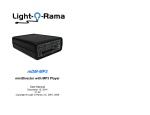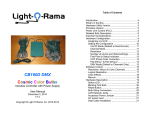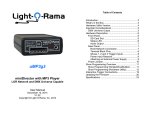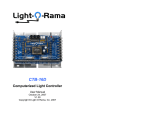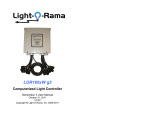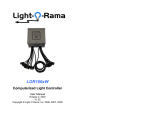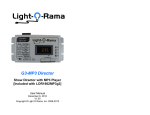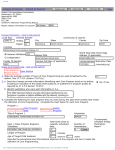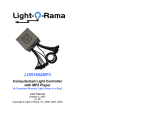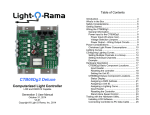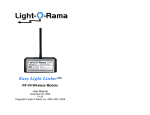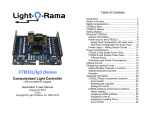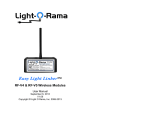Download iDMX1000 User Manual - Light-O-Rama
Transcript
iDMX-1000 Intelligent DMX512 Converter User Manual October 8, 2007 V1.01 Copyright © Light O Rama, Inc. 2007, 2008 iDMX-1000 Table of Contents Introduction.............................................................. 4 What’s in the Box..................................................... 4 Important Considerations......................................... 5 Quick Start Guide .................................................... 6 General DMX Discussion......................................... 7 Experimenting with the Hardware Utility ................ 10 Sequence Editor and iDMX-1000 .......................... 14 Hardware ............................................................... 17 Assigning a Unit ID............................................. 17 Network Connections ......................................... 19 Powering the iDMX-1000 ................................... 20 Data LED ........................................................... 20 DMX Connections .............................................. 20 Polarity Switch.................................................... 21 Select Button...................................................... 21 Resetting the iDMX-1000................................ 21 Starting a Standalone Sequence .................... 21 Status LED......................................................... 22 Termination Resistors ........................................ 22 Nitty-Gritty .......................................................... 23 Hardware Utility Version ........................................ 25 Standalone Mode................................................... 26 Updating the Firmware .......................................... 27 Troubleshooting ..................................................... 30 Refresh does not find the controller ................... 30 Status LED not on at all ..................................... 30 iDMX-1000 Unresponsive – Status LED On/Fluttering ...................................................... 31 DMX Fixture Does Not Respond ........................ 31 Appendix A – LOR/DMX Intensities ....................... 32 Appendix B – Unit ID to DMX Channel .................. 33 Specifications and Features .................................. 35 Introduction The iDMX-1000 is a Light O Rama (LOR) controller that converts LOR protocol to DMX512 protocol. It allows shows designed with the LOR Showtime software to control DMX512 lighting and effects fixtures. Whether the show is controlled by your PC, an LOR Show Director or an LOR controller running in stand alone mode, you can add a new dimension to your display using DMX enabled devices like moving head lights, strobes and smoke machines. The iDMX-1000 can also operate as a stand alone device. Its flash memory can hold 5,000 LOR commands that can direct DMX512 fixtures without being connected to an LOR network. This intelligent device allows access to all 512 channels in a DMX Universe. It also supports 64 intelligent channels that can perform high level LOR controller commands like fades, twinkling and shimmering. There is no configuration for intelligent channels, they are automatically allocated by the iDMX-1000 as needed. What’s in the Box In addition to your iDMX-1000 Converter you will also receive this user manual The latest copy of the manual is available at www.lightorama.com ► Support ► Using the Hardware – Documentation and Firmware section. Page 4 iDMX-1000 iDMX-1000 Important Considerations Quick Start Guide There are two versions of the LOR Showtime Windows software, LOR I and LOR II. LOR I can only handle controllers with 16 circuits or channels. LOR II can handle controllers with 256 circuits or channels. This section assumes that you are familiar with LOR lighting controllers, the Showtime Windows software and that you have Hardware Utility (HWU) version 1.6.5 (see the Hardware Utility Version section) or later and have already configured and connected an RS485 adapter on your PC. Only the first 256 DMX channels can be used by either version of the software. In a future release of the LOR II software, controllers with 512 circuits will be supported. This will make available all 512 channels on the DMX network. The iDMX-1000 supports two addressing modes. 1. Unit ID set to a multiple of 16 (e.g. 10, 20, 30, …E0 in hex) 2. Unit ID set to any other Unit ID between 1 and F0 hex. If its Unit ID is set to a multiple of 16 then it will take 16 Unit IDs in sequence. For example, setting the Unit ID to E0 would allocate Unit IDs E0, E1, E2, ,,, EE & EF to this iDMX-1000. DMX channels 1-16 would be referenced in a sequence by using circuits 1-16 on Unit E0. DMX channels 17-32 would be referenced by using circuits 1-16 on Unit E1, etc. You can use “multiple of 16” Unit ID mode to access 256 DMX channels through a single iDMX-1000 in a LOR I environment. Either Unit ID mode works in a LOR II environment. Appendix B – Unit ID to DMX Channels gives the mapping of LOR Unit IDs and circuits to DMX channels (addresses.) Page 5 This section will get you to the point of controlling a DMX fixture through the iDMX-1000 with the Hardware Utility. If the default Unit ID of E0 hex is not convenient for you, see the Assigning a Unit ID section to change it. The iDMX-1000 must be powered by a USB485B RS485 adapter, a nearby lighting controller or a 12 VDC power pack. See the Powering the iDMX-1000 section for more information. Cable the iDMX-1000 to the PC’s RS485 adapter with a CAT5e LAN cable and start the HWU. The Status LED on the iDMX-1000 should go from blinking to on steady when the HWU is running. Connect your DMX fixture to the DMX Out on the iDMX-1000. Its DMX address range must be less than 256. For this discussion, we will assume the DMX fixture’s start address is 1 which would correspond to Unit ID ‘E0,’ circuit 1 on the LOR network. See the Assigning a Unit ID section for more information. Start the HWU and click the Console button on the upper right. The Test Console window will pop up. In the Controller Type section click the iDMX-1000 radio button. In the DMX Channel Mode section click Page 6 iDMX-1000 iDMX-1000 the Virtual Controllers radio button. Use the Select Unit Id drop down menu to select the address of your iDMX-1000. Since “multiple of 16” unit addressing is being used, only the most significant digit of the address can be selected. The DMX512 specification calls for the use of 5-wire cables using XLR-5 connectors. These cables tend to be very expensive and two wires in the cable are almost never used. It is also inconvenient for theaters to keep separate sets of cables for DMX and audio. For these reasons, most DMX512 fixtures you will see use 3-pin XLR microphone connectors. Adapters that convert between XLR-3 and XLR-5 are readily available. Microphone cables without termination will work in environments with short (100’ or so) cable lengths. Trial and error works here. Pick a DMX address for the device that does something visible like pan. If the pan DMX address is 4, this would be circuit 4 on the LOR network side. Move the slider for DMX channel 4 and the fixture should pan from left to right. If it does not, try changing the Polarity Switch on the iDMX-1000. Refer to the Experimenting with the Hardware Utility section for more information. General DMX Discussion DMX512 (Digital Multiplex) was initially developed by the US Institute of Theater Technology in 1986. It is a very simple system that uses the RS485 electrical protocol to transmit packets of up to 512 bytes. If you are only using DMX channels 1 to 256, then the packet only needs to be 256 bytes. The data rate is 250,000 bits per second. The data packets are transmitted back-to-back as quickly as possible. The maximum length of all cable in a DMX512 network is between 1,000 and 1,500 feet, depending upon the number of DMX fixtures daisy chained. The maximum number of ‘loads’ (usually fixtures) in a daisy chain is 32. It is important to use good quality cables and make sure the network is terminated. ‘Terminated’ means placing a 120 Ω ¼ w resistor between pins 2 & 3 of the cable of the last DMX512 device in the network. Each byte in a DMX512 packet corresponds to a DMX channel. The first byte is channel 1, the second byte is channel 2, … The bytes can have values from 0 (minimum intensity) to 255 (maximum intensity.) How this ‘intensity’ is used is up to the DMX fixture. It could be the actual intensity of the light, or it could be that 0 means ‘all the way to the left’ and 255 means ‘all the way to the right’ for a lighting device with a moving mirror. DMX fixtures usually have many channels assigned to them. You generally set the base address (channel number) of the fixture, and then that address and perhaps the next 7 are also assigned to the fixture. Here is a partial channel assignment for a theoretical light scanner: Channel 1 2 3 4 Page 7 Value 000-255 000-255 000-005 006-128 129-240 241-255 000-025 Function Pan, Left ►Right, 128 = center Tilt, Up ► Down. 128 = center Shutter closed (no light) Shutter open (0-100%) Variable Strobe (slow ► fast) Shutter fully open (max light) White Page 8 iDMX-1000 iDMX-1000 5 026-050 051-075 076-100 101-125 126-150 151-175 176-255 000-015 016-031 032-047 048-063 064-079 080-095 … Red Blue Yellow Green Orange Purple Linear color change Gobo 1 Gobo 2 Gobo 3 Gobo 4 Gobo 5 Gobo 6 … Figure 1 You could configure this fixture to be on DMX channels 1-5, or you could use its address setting configuration menu to change it to channels 17-21. If it were moved to DMX channels 17-21, then DMX channel 21 would be used to select the ‘Gobo.’ (Gobos are translucent films that can be rotated in front of the light to overlay patterns or shapes) Notice that there is often a range of values that select a function. This is done because these fixtures are often controlled by light boards with sliders being moved by humans. People are not accurate enough to move a slider to the 203rd position out of 255, so the fixtures respond to a range. DMX fixtures are daisy chained together. They are normally given unique address ranges so that each fixture can be controlled individually. Remember that the values in the DMX512 packet are being transmitted over and over. If the light Page 9 controller (person using a console or iDMX-1000 converter) changes a channel that controls intensity, then the fixture that is looking at that channel will see the new value the next time a packet is transmitted. The fixture will then move to the new intensity. Even with all 512 channels in use, the packets are being transmitted over 40 times every second. See the Experimenting with the Hardware Utility and Sequence Editor and iDMX-1000 sections for information on using DMX fixtures with LOR effects. Experimenting with the Hardware Utility This section explains how to use the Hardware Utility (HWU) on your PC to experiment with DMX fixture(s) attached to your iDMX-1000. You must have HWU version 1.6.5 or later, see the Hardware Utility Version section. You can use the HWU to experiment with different intensities to determine how the fixture reacts. Depending upon the DMX channel referenced and the capabilities of the DMX fixture, the intensity may select the lamp’s brightness, the color of the light, a gobo, the horizontal or vertical position, etc. You can also experiment to determine starting & ending fade percentages and fade rates to determine what fade will move the light beam from the starting position you want to the ending position you want in the time you want. If one DMX channel controls pan and another controls tilt, in the Sequence Editor you can simultaneously fade both channels to get the light to move in both directions at once. Page 10 iDMX-1000 iDMX-1000 If you do not have the iDMX-1000 cabled to your PC, see the Assigning a Unit ID section (it is ok at this point to have other controllers connected to the LOR network.) For the purposes of this demo, the theoretical light scanner from General DMX Discussion section will be our test case, and it will be configured to use DMX addresses 1 to 5. This means that it will be circuits 1 to 5 on the iDMX-1000. Refer back to Figure 1 for the DMX channels assignments. Start the Light O Rama Control Panel: click start ► All Programs ► LightORama ► Light-O-Rama Control Panel. There will be a light bulb with a blue halo on the right side of the task bar at the bottom of the screen. Right-click the light bulb and select Hardware Utility (HWU) from the menu. You will see this window: In the Controller Type section on the lower left, click the iDMX-1000 radio button. In the DMX Channel Mode section on the lower right, there are two options: 1. Virtual Controllers – in this mode, the iDMX1000 appears as 16 consecutive controllers starting at the base Unit ID. You will only be able to select the most significant digit of the Unit ID from the Select Unit Id drop down menu. 2. Extended Circuit Ids – in this mode, the iDMX1000 appears as one 256 channel controller. This mode is not supported by the LOR I Sequence Editor, but is supported by the LOR II Sequence Editor. Click the Console button on the upper right. This will bring up the Light-O-Rama Test Console: Page 11 See the Assigning a Unit ID section for more information on these two modes. In either Unit ID mode, the Select Channel Group slider allows you to choose which block of 16 DMX Page 12 iDMX-1000 iDMX-1000 addresses will be affected by the vertical intensity sliders. The DMX line above the vertical sliders indicates which DMX channel this slider controls. The LOR line just below indicates the LOR Unit ID and circuit number that you would use in the Sequence Editor to affect this DMX channel. DMX channel 1 on our scanner controls pan. Moving the channel 1 slider will cause the fixture to pan. If your fixture does not react, try changing the Polarity Switch on the iDMX-1000. DMX channel 3 on our scanner controls the shutter (DMX fixtures often have lamps that cannot be dimmed, so light output is controlled by a shutter.) Move the channel 3 slider to see how the light output of the fixture behaves. In this case the intensity will not simply increase from 0 to 100% because the intensity values also control shutter strobe (refer back to Figure 1.) About 0 to 50% will cause the light to go from 0 to 100% brightness, then 51% to 100% will cause a slow to fast shutter strobe effect. Under the intensity sliders there are boxes showing the current LOR light intensity as a percentage (0 to 100%,) and the equivalent DMX intensity as a value between 0 and 255. If you want to select a particular Gobo, you need to use the LOR intensity that becomes the DMX value that selects the gobo you want. Referring back to Figure 1, DMX intensities 32 to 47 select Gobo 3. LOR intensities 13% to 18% would be used. This information can also be obtained from Appendix A. Sequence Editor and iDMX-1000 Let’s assume you have two of the theoretical DMX light scanners described in the General DMX Discussion section. Using the scanner’s configuration mechanism, you have set the initial DMX address of the first scanner to DMX channel 1, and the initial address of the second scanner to DMX channel 42. These scanners take five consecutive DMX addresses or channels. This means that the first scanner uses DMX channels 1 to 5 and the second scanner uses DMX channels 42 to 46. We will also assume you are using the “multiple of 16” Unit ID scheme for the iDMX-1000. See the Assigning a Unit ID section for more information. We further assume that the iDMX-1000’s Unit ID is the factory default of ‘E0.’ Scanner one’s DMX channels 1 to 5 would be LOR Unit ID ‘E0’, circuits 1 to 5. Scanner two’s DMX channels 42 to 46 would be LOR Unit ID ‘E2’, circuits 10 to 14. See Appendix B – Unit ID to DMX Channel for more information on mapping “multiple of 16” Unit IDs and circuits to DMX channels. Start the Sequence Editor and create an animation sequence with at least 10 channels. Click the first Channel button and select Light-O-Rama Controller, set the Unit ID to ‘E0’ and the circuit to 1. Click the next Channel button and set the Unit ID to ‘E0,’ circuit 2. When you have configured the first five circuits on Unit ID ‘E0,’ you have defined the first scanner’s channels. Click the next free Channel button and set the Unit ID to ‘E2’ and the circuit to 10. This is the first DMX Page 13 Page 14 iDMX-1000 iDMX-1000 channel on the second scanner. Configure the remaining Sequence Editor channels for Unit ID ‘E2’ circuits 11 to 14. The two scanners are now configured in the Sequence Editor. In the following Sequence Editor Window the channel names have been changed to include the scanner DMX function, scanner number and the LOR Unit ID and circuit number. A 0 to 100% fade has been used in the PAN channel to cause the scanner to move from its extreme left to its extreme right. The fade will cause the scanner to see numeric values between 0 and 255 as the fade proceeds. An intensity of 50% has been set in the TILT channel. This will result in positioning the scanner in the middle of its vertical axis because 50% intensity results in sending 127 to the DMX channel. See Appendix A. Refer back to Figure 1 in the General DMX Discussion section for how the DMX values affect a scanner’s behavior. The next figure shows a simple 2-second sequence that will pan from left to right, vertically centered, full brightness, in the color orange using Gobo 1 for the first 2 seconds and then turn off. The Shutter channel has been set to full intensity. This will result in a 255 being sent to the DMX shutter channel which results in maximum brightness. The Color channel has been set to 50% intensity. This will send a 127 to the DMX color channel resulting in the selection of orange. See Appendix A. Since the Gobo channel is off, it will receive a value of 000, selecting Gobo 1. The window has been resized so it does not display scanner two’s channels: Page 15 Page 16 iDMX-1000 iDMX-1000 Hardware The iDMX-1000 appears in an LOR network as a 512 channel controller. Each LOR channel (circuit) on the iDMX-1000 corresponds to the same channel number (address) in the DMX network. The Unit ID is set using the Hardware Utility. You must have one of the RS485 adapters shown in the next picture installed on your PC. See the Important Considerations and Assigning a Unit ID sections for more information on access to the DMX channels from LOR software. Assigning a Unit ID The default Unit ID from the factory is ‘E0’ hex. If the Unit ID is set to a multiple of 16 (10, 20, 30, …E0 hex,) then the iDMX-1000 will take 16 Unit IDs in sequence. For example, setting the Unit ID to ‘E0’ would allocate Unit IDs ‘E0,’ ‘E1,’ ‘E2,’ ,,, ‘EE’ & ‘EF’ to this iDMX-1000. DMX channels 1 to16 would be referenced in a sequence by using circuits 1 to16 on Unit ‘E0.’ DMX channels 17 to 32 would be referenced by using circuits 1 to16 on Unit ‘E1’, etc. See Appendix B – Unit ID to DMX Channel for this mapping. We recommend using a Unit ID on a 16 boundary since this will allow portability between old and new versions of the LOR software. If you have the SC485 serial adapter shown on the left, you need only plug it into a serial port on your PC. If you have either of the USB adapters (USB485B, USB485) shown center and right, follow the directions that came with the adapter to install it. You must have the LOR Showtime Windows software installed on your PC. If you are using the SC485 or USB485 to connect the iDMX485 to your PC, you will need a 12 VDC power supply to power the iDMX-1000. Cable ONLY the iDMX-1000 to the PC through the RS485 adapter. The status LED on the iDMX-1000 should be blinking – indicating that it is powered and ready to receive commands. If the Unit ID is set to a value between ‘01’ and ‘F0' hex that is not on a multiple of 16 boundary, then the iDMX-1000 only responds to that ID. Circuits 1 through 512 on this iDMX-1000 correspond to DMX channels 1 through 512. (‘F0’ is not treated as a multiple of 16 because it is the highest legal ID.) Start the Light O Rama Control Panel: click start ► All Programs ► LightORama ► Light-O-Rama Control Panel. Answer OK to any initialization boxes. There will be a light bulb with a blue halo on the right side of the task bar at the bottom of the screen. Right-click the light bulb and select Hardware Utility (HWU) from the menu. You will see this window: Page 17 Page 18 iDMX-1000 iDMX-1000 LAN cable to connect your iDMX-1000 to other controllers. If you use phone cable, the other end of the phone cable must go into the “Phone Cable In” jack of the other device. If the other device does not have a “Phone Cable In” jack, then you must use CAT5e cable to connect the iDMX-1000 to it. Powering the iDMX-1000 In the Change Existing ID section on the lower left, use the Old Unit ID drop down menu to select “Any Unit” and click OK to the pop up box. Use the New Unit ID drop down menu to select the unit ID you want and click the Change Unit ID button. Note the New Unit ID drop down menu will only list as many units as the Max Units section (upper right) permits. If you want a higher unit ID than the current limit, change the Max Units and stop and restart the HWU. Once the Unit ID is set, it does not change, even if the iDMX-1000 is reset. The iDMX-1000 can be powered three ways: 1. By a USB485B RS485 adapter over the network cable 2. By a nearby LOR controller over the network cable 3. By a 12 VDC 500 milliamp power supply plugged into the power barrel If the iDMX-1000 is to be powered over the network cable, the cable length should be limited to 50’ or less to prevent excessive voltage drop. Data LED Blinks once for every 40 DMX packets transmitted if no DMX input detected on the DMX In connector. Steady on when a DMX input signal is being passed through to the DMX output. DMX Connections Network Connections The two RJ45 LOR Network Connection jacks on the iDMX-1000 may be used interchangeably. You must use CAT5e LAN cables to connect the iDMX-1000 to your PC or Show Director. You should use CAT5e Page 19 The following figure shows the DMX connector end of the iDMX-1000. Page 20 iDMX-1000 iDMX-1000 Status LED LED blinking approximately twice/second: Controller has booted correctly and is waiting for commands. The controller is not connected to a Light O Rama network or the network is not active. LED is on solid: Controller is connected to an active network (is receiving the heartbeat and commands from a PC, a Show Director or another controller) Polarity Switch This switch reverses pins 2 and 3 on the DMX out connector. Normal polarity is with the switch to the right as shown in the preceding figure. This switch is needed to drive some improperly connected DMX fixtures (notably some older Martin equipment.) Select Button Resetting the iDMX-1000 Power the iDMX-1000 off, hold down the Select button and power the iDMX-1000 on. The Status LED will blink rapidly. Once it starts blinking rapidly, you can release the Select button and the unit will run normally. Starting a Standalone Sequence If a standalone sequence has been downloaded into the flash memory of the iDMX-1000, the Select button may be used to start it. See the Standalone Mode section for more information. LED blinks on for a long pulse and off for a short pulse: Controller firmware needs to be downloaded. See the Updating Controller Firmware section. LED flutters: Controller is running a standalone sequence or downloading firmware. Termination Resistors See the General DMX Discussion section for information about termination resistors. Even though the iDMX-1000 may be inserted into a DMX network at any point, both of its DMX XLR-3 connectors are at the physical end of the network to which they are connected. From an electrical point of view, there is one DMX network on the DMX In connector and one DMX network on the DMX Out connector. The cable connected to the DMX In connector is not hardwired to the cable on the DMX Out connector. The data received on the DMX In connector is sent to the iDMX-1000’s microprocessor. Data sent on the DMX Out connector is created by the iDMX1000’s microprocessor. For this reason, there are termination resistors on the signal lines of both connectors. Normally these Page 21 Page 22 iDMX-1000 iDMX-1000 resistors do not cause problems, in fact, they are required by the DMX512 Specification. There are internal jumpers that may be removed to individually remove these resistors. You must open the iDMX1000 to remove the resistors. standalone) affects any DMX channel above 256, then the iDMX-1000 switches to a packet size of 512. To open the iDMX-1000, remove the 4 end screws from the Light-O-Rama network connection side of the case. Slide the circuit board out by pulling on the DMX In/Out connector side of the case. Break is 225 microseconds. The following picture show the location of the termination resistor jumpers. Remove the jumper to remove the termination resistor. The packets per second rate is approximately 80 with 256 channels and 40 with 512 channels. Mark-After-Break (MAB) is 25 microseconds. The iDMX-1000 appears as a 512 circuit controller on the LOR Network. It maps LOR circuits 1-to-1 to DMX channels on the DMX side. Simple LOR commands like ‘on,’ ‘off’ and ‘set intensity’ do not require intelligent channels on the iDMX-1000. In these cases, an LOR intensity is converted to a DMX value (see Appendix A) and this value is constantly transmitted on the DMX side until changed by the LOR side. If a circuit on the LOR side is commanded to fade up or down, twinkle or shimmer, the iDMX-1000 must allocate an intelligent channel to perform the function. The iDMX-1000 has a pool of 64 intelligent channels (ichans) from which it automatically allocates one ichan at a time. Twinkle and shimmer allocate an ichan to that circuit until the effect is turned off. Fade up/down allocate an ichan to the circuit until the fade is complete. Nitty-Gritty The iDMX-1000 normally transmits a DMX512 packet with 256 channels. Channels not actually in use are set to 000. This is done because short packets confuse some DMX fixtures and they do not see the packets at all. If an LOR command (from the Sequence Editor, Show Director or another controller running Page 23 The process of allocating and releasing ichans is transparent to you. If you try to use more than 64 effects that require an ichan simultaneously, the current effect will do one of the following: • Shimmer – go to 100% intensity • Twinkle – go to 100% intensity • Fade Up/Down – go to the ending intensity Page 24 iDMX-1000 iDMX-1000 When the iDMX-1000 is first powered up or reset, the default mode is to pass through all DMX channels received on the DMX In connector to the DMX Out connector. When LOR commands are received that affect DMX channels, blocks of 16 channels are removed from the input stream on 16 byte boundaries. For example, if an LOR command to fade DMX channel (address) 19 is received, then channels 17 through 32 will not be passed through. Channels in that range that are not affected by LOR commands will be transmitted as 000 on the DMX side. Standalone Mode LOR Fade up/down commands can use all 256 possible values on the DMX side. Intensity commands on the LOR side are specified as a percentage from 0 to 100. See appendix A for the mapping of LOR 1 to 100% intensities to DMX 000 to 255 intensities. The sequence is designed and tested using the Showtime Software Sequence Editor. When you are happy with the sequence, save it and exit the Sequence Editor. Hardware Utility Version You must have Hardware Utility version 1.6.5 or later to use the iDMX-1000 in a reasonable manner. The version of the Hardware Utility appears in the title bar to the right of “Light-O-Rama Hardware.” If the version number is less than 1.6.5 or there is no version number at all, then you need a new Hardware Utility. The latest version is available for download at www.lightorama.com ► Support ► Software Downloads. Click the Download button to the left of the Hardware Utility and run the installer. A stand alone animation sequence (sequence with no accompanying audio) can be downloaded into the flash memory of the iDMX-1000’s micro. This sequence can contain approximately 5,000 LOR commands. These commands can also be for controllers other than this iDMX-1000, so this controller can direct a network of controllers in addition to the DMX fixtures attached to it. There are no restrictions on the types of LOR controllers in this network. Start the Hardware Utility (see the Experimenting with the Hardware Utility section) and click the Refresh button to find the iDMX-1000. Use the drop down menu next to the Refresh button to select the iDMX-1000. Remember, if the Unit ID of the iDMX1000 in on a 16 boundary (see the Assigning a Unit ID section) the iDMX-1000 will show up as 16 controllers in the drop down menu. Select the lowest numbered address. Tip: If your iDMX-1000 is at the default address of ‘E0’ or you know its address, it is easier to enter the address in the box to the right of the Refresh button. Click the Standalone button at the bottom of the window. Select one of the radio buttons: • Run when power is on – the sequence will execute whenever the iDMX-1000 is powered Page 25 Page 26 iDMX-1000 • • Input (norm open switch) – the sequence will run once when the Select button is pressed Input (norm closed switch) – the sequence will run continuously after the Select button is pressed, the iDMX-1000 must be powered off to stop the sequence Then click the Send Trigger info to Unit button. Finally, Use the Open button to browse to your sequence and click the Download button. You also use this screen to remove downloaded standalone sequences. You can also remove a standalone sequence by resetting the iDMX-1000, see the Resetting the iDMX-1000 section. iDMX-1000 Start the LightORama Control Panel if it is not running by clicking start ► All Programs ► LightORama ► Light-O-Rama Control Panel. The Light-O-Rama light bulb icon will appear in the system tray on the lower right of your screen. Start the Hardware Utility by right-clicking the LightO-Rama Control Panel light bulb and selecting Hardware Utility from the menu. Click the Firmware button in the LOR Control tab and you will see this window: Updating the Firmware You must have: • • • Hardware Utility version 1.5.8 or later, see the section Hardware Utility Version The iDMX-1000 powered, see the Powering the iDMX-1000 section The iDMX-1000 connected to the PC via one of the RS485 adapters (do not use wireless,) see the Assigning a Unit ID section for more information Get the latest firmware. www.lightorama.com ► Support ► Using the Hardware – Documentation and Firmware section. Click the Firmware button in the iDMX-1000 line and run the firmware installer. Note the name of the firmware .lhx file. The normal location of firmware files is C:\Program Files\Light-ORama\Firmware. Page 27 The best way to download firmware is to have only the iDMX-1000 cabled to the PC and click the “Only one unit is connected” radio button under Step1 – Select Unit. You can also use the Refresh button to find the iDMX-1000, but if it is assigned a Unit ID on a multiple of 16 ID boundary (see the Assigning a Unit ID section,) it will appear as 16 controllers in the drop down menu next to the Refresh button. Only Page 28 iDMX-1000 the first Unit ID, the one on the 16 boundary, can be downloaded. Use the drop down menu to select the lowest Unit ID assigned to the iDMX-1000 and click the “Select unit listed above” radio button under Step1 – Select Unit. Tip: If your iDMX-1000 is at the default address of ‘E0’ or you know its address, it is easier to enter the hex address in the box to the right of the Refresh button. In Step 2 – Select firmware file, click the Open button. Use the Open file box to select the firmware file. This is the .lhx file you saved in the Firmware folder earlier. Click the Open button in the Open box. The window will look like this: iDMX-1000 The Update progress bar will fill from left to right. When the new firmware is loaded, the Status will change to “Successful” and the iDMX-1000 will reboot. Troubleshooting Refresh does not find the controller You have previously: successfully configured the comm port, manually selected the comm port or used another controller to Autoconfigure the comm port. In other words, you’re sure the RS485 adapter has been properly installed and is working. When the iDMX-1000 is powered but no data cable is connected to it, the Status LED should be blinking. This means that the controller is working, but is not in communication with a Show Director or PC. If the Hardware Utility is running, the RS485 adapter is properly configured and you attach a cable from the RS485 adapter to the controller, this Status LED should go to steady on. If this is not the case, then either the RS485 adapter is not properly installed, the Hardware Utility is not running or some component is broken. If the light does go steady on, then manually type the Unit ID in hex into the box to the right of the Refresh button in the Hardware Utility. See the Experimenting with the Hardware Utility section to test the controller. In Step 3 – Press Download Button, click the Download button – the firmware download will start automatically. Page 29 Status LED not on at all This means the iDMX-1000 is not powered or broken. See the Powering the iDMX-1000 section. Page 30 iDMX-1000 iDMX-1000 Unresponsive – Status LED On/Fluttering There is probably a standalone sequence loaded into the iDMX-1000. See the Resetting the iDMX1000 section to remove the standalone sequence. DMX Fixture Does Not Respond The iDMX-1000 is connected to the PC and its Status LED is on steady indicating that it sees the heartbeat message from the Hardware Utility, Show Director, etc. Try changing the Polarity Switch on the .DMX-1000. See the Polarity Switch section. Page 31 iDMX-1000 Appendix A – LOR/DMX Intensities The following table shows the mapping of an LOR intensity to a DMX intensity. LOR intensities run from 0 to 100%, DMX from 000 to 255. LOR 0 1 2 3 4 5 6 7 8 9 10 11 12 13 14 15 16 17 18 19 20 21 22 23 24 25 26 27 28 29 30 31 32 33 DMX 0 2 5 7 10 12 15 17 20 22 25 28 30 33 35 38 40 43 45 48 51 53 56 58 61 63 66 68 71 73 76 79 81 84 LOR 34 35 36 37 38 39 40 41 42 43 44 45 46 47 48 49 50 51 52 53 54 55 56 57 58 59 60 61 62 63 64 65 66 67 DMX 86 89 91 94 96 99 102 104 107 109 112 114 117 119 122 124 127 130 132 135 137 140 142 145 147 150 153 155 158 160 163 165 168 170 Page 32 LOR 68 69 70 71 72 73 74 75 76 77 78 79 80 81 82 83 84 85 86 87 88 89 90 91 92 93 94 95 96 97 98 99 100 DMX 173 175 178 181 183 186 188 191 193 196 198 201 204 206 209 211 214 216 219 221 224 226 229 232 234 237 239 242 244 247 249 252 255 iDMX-1000 Appendix B – Unit ID to DMX Channel The following table shows the mapping of LOR Unit ID and circuit numbers to DMX channels when using the “multiple of 16” Unit ID scheme. See the Assigning a Unit ID section for more information. In the following table, ‘x’ is 1, 2, 3, 4, 5, 6, 7, 8, 9, A, B, C, D or E. It is the most significant hex digit of the Unit ID. Unit ID x0 x1 x2 x3 x4 x5 x6 x7 LOR circuit=DMX channel 1=1, 2=2, 3=3, 4=4, 5=5, 6=6, 7=7, 8=8, 9=9, 10=10, 11=11, 12=12, 13=13, 14=14, 15=15, 16=16 1=17, 2=18, 3=19, 4=20, 5=21, 6=22, 7=23, 8=24, 9=25, 10=26, 11=27, 12=28, 13=29, 14=20, 15=31, 16=32 1=33, 2=34, 3=35, 4=36, 5=37, 6=38, 7=39, 8=40, 9=41, 10=42, 11=43, 12=44, 13=45, 14=46, 15=47, 16=48 1=49, 2=50, 3=51, 4=52, 5=53, 6=54, 7=55, 8=56, 9=57, 10=58, 11=59, 12=60, 13=61, 14=62, 15=63, 16=64 1=65, 2=66, 3=67, 4=68, 5=69, 6=70, 7=71, 8=72, 9=73, 10=74, 11=75, 12=76, 13=77, 14=78, 15=79, 16=80 1=81, 2=82, 3=83, 4=84, 5=85, 6=86, 7=87, 8=88, 9=89, 10=90, 11=91, 12=92, 13=93, 14=94, 15=95, 16=96 1=97, 2=98, 3=99, 4=100 5=101 6=102 7=103 8=104 9=105 10=106 11=107 12=108 13=109 14=110 15=111 16=112 1=113 2=114 3=115 4=116 5=117 6=118 7=119 8=120 9=121 10=122 11=123 12=124 13=125 14=126 15=127 16=128 Page 33 iDMX-1000 x8 x9 xA xB xC xD xE xE 1=129 2=130 3=131 4=132 5=133 6=134 7=135 8=136 9=137 10=138 11=139 12=140 13=141 14=142 15=143 16=144 1=145 2=146 3=147 4=148 5=149 6=150 7=151 8=152 9=153 10=154 11=155 12=156 13=157 14=158 15=159 16=160 1=161 2=162 3=163 4=164 5=165 6=166 7=167 8=168 9=169 10=170 11=171 12=172 13=173 14=174 15=175 16=176 1=177 2=178 3=179 4=180 5=181 6=182 7=183 8=184 9=185 10=186 11=187 12=188 13=189 14=190 15=191 16=192 1=193 2=194 3=195 4=196 5=197 6=198 7=199 8=200 9=201 10=202 11=203 12=204 13=205 14=206 15=207 16=208 1=209 2=210 3=211 4=212 5=213 6=214 7=215 8=216 9=217 10=218 11=219 12=220 13=221 14=222 15=223 16=224 1=225 2=226 3=227 4=228 5=229 6=230 7=231 8=232 9=233 10=234 11=235 12=236 13=237 14=238 15=239 16=240 1=241 2=242 3=243 4=244 5=245 6=246 7=247 8=248 9=249 10=250 11=251 12=252 13=253 14=254 15=255 16=256 Page 34 iDMX-1000 Specifications and Features Light O Rama Effects Supported DMX Channels Supported Intelligent Channels for fades, shimmer and twinkle Standalone Flash Storage Lighting Console Support DMX Output Polarity Reversal Switch Multiple iDMX-1000 controllers in a Light O Rama Network Casing LOR Network Connections DMX Network Connections Power On, Off, Intensity, Fade Up/Down, Twinkle and Shimmer 512 64 Up to 5,000 Light O Rama commands Pass through mode to allow some fixtures to be manually controlled Yes (needed for some older fixtures) Yes, allows support for multiple DMX universes Industrial quality anodized aluminum Two RJ45 jacks Female XLR-3 DMX Out Male XLR-3 DMX In Normally by nearest controller or USB485B RS485 adapter. Optional power brick also available Page 35 Light-O-Rama, Inc. Tel: (518) 539-9000 Fax: (518) 538-0067 info@lightorama.com


















